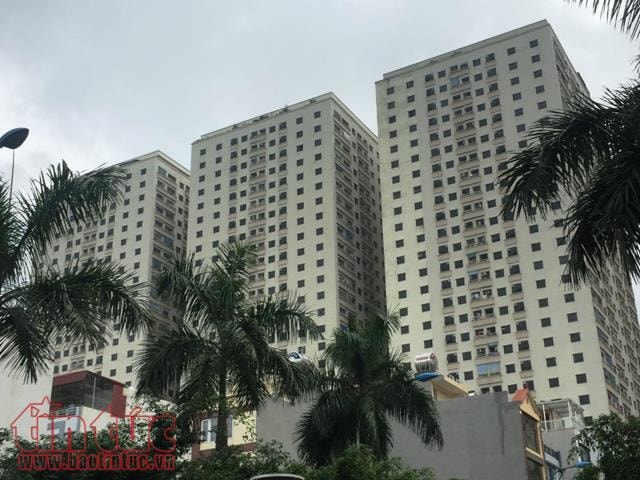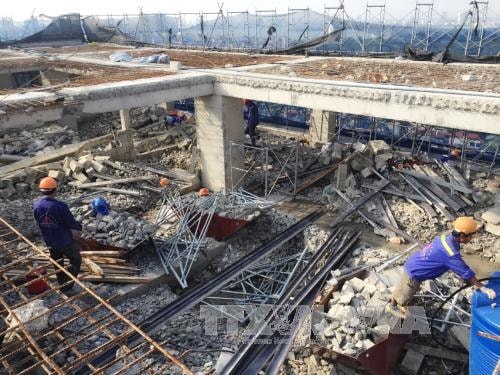Illegal housing construction is increasingly 'immune' to the law?
Violations of construction regulations in housing projects are on the rise. It seems that every project has violations. Are investors becoming immune to the law because of lax management?
Recently, the Government Inspectorate announced the conclusion of the inspection on construction investment management in 38 housing and urban development projects in Hanoi in the period 2002-2014, in which it pointed out a series of violations during the project implementation process. The Government Inspectorate proposed to recover the amount of violations up to 1,562 billion VND.
This number makes many people surprised. Because large-scale construction projects, to be approved and implemented, must go through many levels of authority. Not to mention the construction inspection team "covering" all districts. Why are violations still not detected? Is there a cover-up, intentional ignorance or lax management?
Dai Thanh apartment building (Thanh Tri, Hanoi) built more floors than the number of floors. |
The main violations pointed out by the Government Inspectorate are: not paying land use fees; determining the financial obligations of investors incorrectly or insufficiently; project investors adjusting land use planning and construction planning but not fulfilling financial obligations for the increased area; determining land use fees of the project at incorrect locations specified in the land price list...
In recent years, a series of illegal constructions have been taking place in many localities across the country. Especially in Hanoi, many constructions that violate construction order have caused public outrage, such as the 8B Le Truc building, projects that disrupt urban planning by the investor Muong Thanh... What the public is concerned about is why these illegal constructions have not been handled or demolished but have "proudly" existed for so many years.
Even though I know it's wrong, it's... awkward.
Mr. Bui Trung Dung, Director of the Department of Construction Management (Ministry of Construction) said that according to the 2014 Construction Law, the management of construction permits must have construction planning and regulations on architectural planning management. This is the legal basis for granting construction permits, avoiding the situation of asking and giving.
In the past years, the 'coverage' of planning was very low, so the construction licensing agency had a tendency to ask and give. When there was a violation, it was difficult to enforce demolition. Later, when there were more plans, if there was a violation of the announced planning and architectural management, it could be demolished. If the violation did not affect the general architectural planning or the previous construction planning, it would not be demolished.
Also for this "historical" reason, at the second quarter 2017 press conference of the Ministry of Construction on August 2, Deputy Minister Le Quang Hung said that in the past year, there were about 60,000 different construction permits, including small construction permits and permits for entire projects. The Ministry of Construction's viewpoint is to handle all illegal constructions.
"There are violations, specifically without permission or without permission. However, it is necessary to evaluate the process," Mr. Hung said.
According to Mr. Hung, in 2010-2011, the system of legal documents regulating management and licensing was not complete, leading to the occurrence of a mechanism of asking for permission or violations that were difficult to handle.
Nowadays, the legal basis is increasingly complete, there are specific guiding decrees, and there are sanctions and handling methods. Thanks to that, the rate of illegal construction has decreased. However, there are still illegal and unlicensed constructions, including small and large constructions.
"The Ministry's handling viewpoint is that if there is no permit, construction must be suspended. If there is no permit, procedures must be followed to obtain permission, and demolition may be forced. If there is no permit, construction must be suspended, and the permit and planning must be compared," said Deputy Minister Hung.
According to the Deputy Minister, it is necessary to review the nature of illegal construction as it is still an asset. If construction is underway, it must be handled. If construction has been completed and is in accordance with planning, the difference due to violations will be collected.
The demolition of the illegal part at 8B Le Truc construction site has not been completed yet. |
Penalty for existence increases violations?
According to Chief Inspector of the Ministry of Construction Nguyen Ngoc Tuan, to exist, illegal constructions must ensure the following conditions: no boundary violations, legal land, no disputes, and stable residents.
Mr. Tuan cited an example: a house under construction has 4 floors but is being built to 5 floors, it would be a waste to demolish it, so it should be allowed to exist if the planning allows for 5 floors. If it is allowed to exist, the government will collect 50% of the value of the illegal construction.
This "penalty for existence" solution may seem "humane" at first, avoiding waste, but it is also causing violations to increase, and many investors are even "immune to the law", willing to violate to pay the fine. Because in reality, the value of the illegal construction is often much larger than the amount of fines (due to the advantages of the project's location).
According to the Hanoi Department of Construction, in the first 6 months of the year, the Department Inspectorate issued 940 decisions on administrative violations with a total fine of more than 9.5 billion VND. This amount is "insignificant" compared to the value of housing arising from illegal construction for project owners.
Therefore, according to construction experts, construction order management must be done from the root, preventing violations from the root. When there are signs of violations or illegal construction, the management agency needs to "blow the whistle" immediately, not wait until "the matter is done" to solve it, and then "punish for it to exist". Doing so not only makes investors "immune to the law" but also creates conditions for a group of officials to "collude" with businesses.
Previously, at the meeting of the Hanoi People's Council in July, answering questions about handling violations of construction order, Vice Chairman of the City People's Committee Nguyen The Hung said: "The regulations on handling violations of construction order are complete. The current situation of construction violations is caused by the lack of determination of local management officials and local authorities; the awareness of investors and a part of the people deliberately violate. Therefore, in the coming time, the city will direct the resolute handling of violations of construction order; if there are intentional violations, criminal proceedings will be taken."
It is time to tighten the construction management process. Where violations of construction order occur, construction inspectors and local leaders must be held responsible. Only then can civilized and urban order be restored.
According to Hoang Duong/baotintuc
| RELATED NEWS |
|---|


